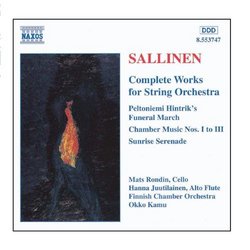Great Music by a Fellow Countryman of the Reviewer
Olli Hietamaa | Hämeenkoski, Finland | 02/22/2000
(5 out of 5 stars)
"Aulis Sallinen (b. 1935) is maybe the most famous Finnish composer abroad apart from Sibelius (or at least he was before Rautavaara), and String Quartet No. 3 (1970, arrangation for string orchestra 1981) is probably his best-known instrumental work - at least in Finland (Washington Mosaics, for example, might be better known abroad). Quartet No. 3 isn't a "real" string quartet in sonata form, but a one-movement series of variations on the Finnish folk tune Hintriikki Peltoniemi's Funeral March (better translation). The first two Chamber Musics make use of similar techniques, and elements of folk music are also present in them, though not so obviously. I (1975) is scored for pure strings, while II (1976) gets a special colour from a solo part for alto flute.A common feature to these three works is that they are all (intentionally) short of thematic material, but it's viewed in many different aspects and varied richly through various possibilities of composition and playing that modern music can provide. Still, Sallinen's work is firmly based on traditions of tonality and melody which have sometimes made him known as a "Neo-Romantic" composer. His music is also easily approachable because of clarity, spontaneity and the unique feel of "joy of invention" that has been its characteristic trademark from the beginning.In the two remaining works from the 1980s the "Neo-Romantic" epithet becomes more and more justified. Both compositions make use of some material from Sallinen's celebrated operas (The King Goes to France and Kullervo) and there's a slight touch of programme music in themselves, too. Chamber Music III (1986) contains a solo part for cello - a close instrument to Sallinen, whose major works include a concerto for it. This 20-minute work is a series of highly rhythmic and energetic dancing pieces, often with a grotesque or humoristic nature. The briefer Sunrise Serenade (1989) for 2 trumpets, piano and strings might be continuation to "The Nocturnal Dances of Don Juanquixote", being an evocative "Neo-Impressionistic" depiction of the transition from dark to light.In my opinion, Sallinen has succeeded perfectly in combining musical elements of today and the past. Due to his traditional starting points, this music might be particularly suitable to be listened by those who are afraid of the so called modern music or want to familiarize themselves with it but don't know what to start with. And, as hard as it is to find contemporary music on CD with reasonable prices, this recording by first-class artists should be noticed by every music lover at all."


 Track Listings (5) - Disc #1
Track Listings (5) - Disc #1